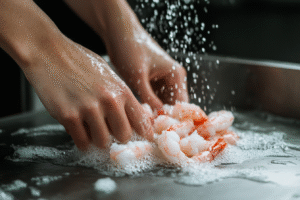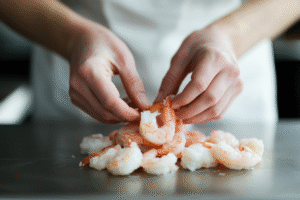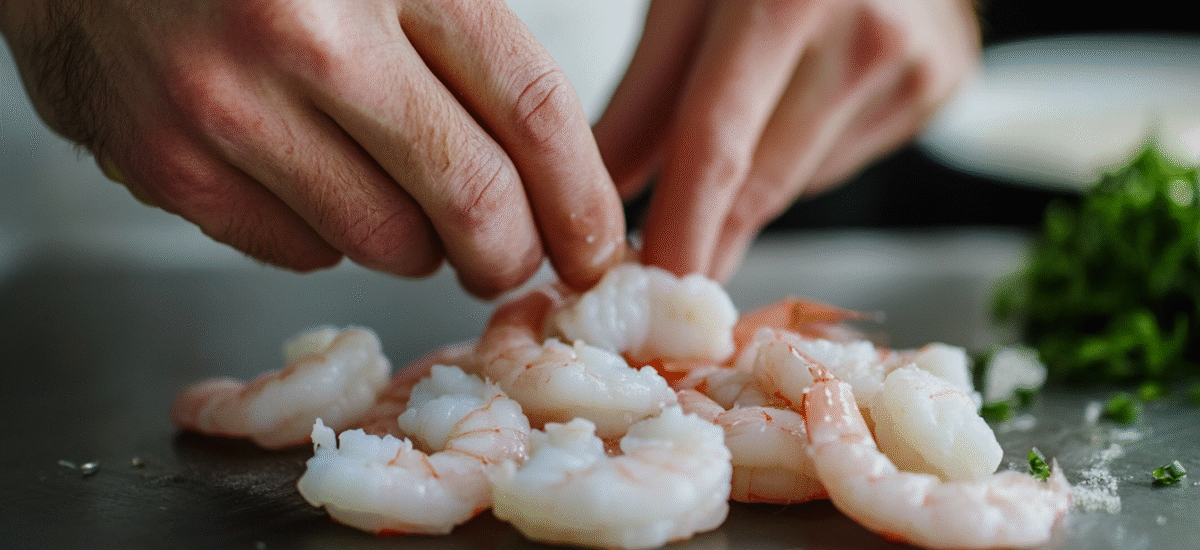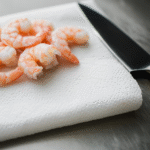Learn how to clean, buy, and cook shrimp like a pro with this complete guide. Includes shrimp sizing, wild vs. farmed info, cooking tips, and FAQs.
Mastering Shrimp: From Selection to Cleaning, Cooking and Beyond
If there’s one seafood that consistently wins over hearts (and plates) across cultures and cuisines, it’s shrimp. Tender, quick-cooking, and endlessly versatile, shrimp is a staple in everything from Southern shrimp and grits to Spanish paella, Italian scampi, Thai curries, and backyard shrimp boils. Whether grilled, sautéed, fried, or tossed cold into a salad, shrimp has a way of elevating any dish with its delicate flavor and satisfying bite.
But for all its popularity, shrimp can also be a bit mysterious to home cooks. What does “26/30 count” mean? Should I buy it frozen or fresh? What’s the difference between wild-caught and farm-raised? And most importantly—how do I properly clean and cook shrimp without turning it rubbery?
In this comprehensive guide, we’ll cover everything you need to know about shrimp, starting with how to clean them the right way. We’ll walk you through the essential tools, step-by-step cleaning instructions, and provide visual. You’ll learn how shrimp are sized, what flavor differences exist between types, how water sources affect taste and texture, and how to tell the best shrimp from the rest. We’ll also touch on the fascinating role shrimp plays in American cuisine, with over a billion pounds consumed annually in the U.S. alone.
And when it’s time to cook? We’ve included a complete shrimp cooking guide with temperatures, times, and tips to help you nail it every time—whether you’re a beginner or a seasoned pro.
Ready to dive in? Let’s demystify shrimp and give you everything you need to select, prep, and cook shrimp like a chef.
Ingredients
- Thawed Shrimp
🔪 Tools You’ll Need to Clean Shrimp
Cleaning shrimp is quick and easy with the right tools:
- A small sharp paring knife or shrimp deveiner tool
- Bowl of ice water
- Trash bowl for shells
- Paper towels
- Optional: gloves if preferred
Instructions
Step 1: Rinse the Shrimp
Place shrimp in a colander and rinse under cold water to remove any surface residue or sand.

Step 2: Remove the Shell
Hold the shrimp firmly, peel off the shell starting from the legs, and leave the tail on or off depending on your recipe.
Step 3: Devein the Shrimp
Use a paring knife to make a shallow cut along the back. Pull out the black or brown vein using the tip of your knife or fingers.

Step 4: Rinse Again & Pat Dry
Give cleaned shrimp a final rinse and gently pat dry with paper towels.
Notes
Shrimp Sizes and What They Mean
Shrimp are sold by count per pound, not by name. Here’s what that means:
| Size Name | Count per Pound | Common Uses |
|---|---|---|
| Extra Small | 61–70 | Salads, stir-fries |
| Small | 51–60 | Pasta, fried rice |
| Medium | 41–50 | Tacos, skewers |
| Large | 31–40 | Scampi, sautés |
| Extra Large | 26–30 | Grilling, roasting |
| Jumbo | 16–25 | Cocktail, main dishes |
| Colossal | U15 | Surf & turf, special events |
🌊 Wild vs. Farm-Raised Shrimp: What’s the Difference?
Flavor:
-
Wild-caught shrimp tend to have a firmer texture and a more “oceanic” flavor due to natural diets.
-
Farmed shrimp can vary depending on farming conditions and feed.
Sustainability:
-
U.S. wild-caught shrimp from the Gulf or Pacific are often more sustainable.
-
Look for third-party certifications on farmed shrimp like ASC, BAP, or MSC (Monterey Bay Aquarium, 2025).
Water Source Impact:
-
Saltwater shrimp (like ocean-caught) often have a stronger, brinier flavor.
-
Freshwater shrimp are usually milder and sweeter.
🛍️ How to Buy Shrimp
-
Raw or Cooked: Always buy raw if you plan to cook it yourself for better flavor and control.
-
Frozen or Fresh: Frozen shrimp is often fresher than “fresh” since it’s flash-frozen right after harvest.
-
Peeled & Deveined: Convenient but more expensive. Great for fast weeknight meals.
-
Shell-On: More flavor when cooked, ideal for grilling or boiling.
Shrimp Consumption in the U.S.
Shrimp is America’s favorite seafood. The U.S. consumes over 1.5 billion pounds of shrimp annually, making it the most popular seafood in the country (National Fisheries Institute, 2023). Most shrimp sold in the U.S. is imported and farmed, although domestic wild-caught options are still available and valued for their higher quality.
🔥 Shrimp Cooking Guide
Shrimp cook fast—here’s how to nail it:
⏱️ Cook Time by Size
| Shrimp Size | Approx. Cook Time |
|---|---|
| Small (51/60) | 1–2 minutes |
| Medium (31/40) | 2–3 minutes |
| Large (26/30) | 3–4 minutes |
| Jumbo (16/20) | 4–5 minutes |
✅ Doneness Clues
-
Color: Opaque white and pink
-
Shape: A perfect “C” (not a tight “O”)
-
Texture: Firm, not rubbery
🍳 Cooking Methods
Sauté or Pan-Fry: 2–3 minutes per side
Grill: 2–3 minutes per side (medium-high heat)
Boil or Poach: 2–3 minutes until shrimp float
Roast: 8–10 minutes at 400°F
Air Fry: 400°F for 5–6 minutes
❓ Shrimp FAQs
Why do frozen shrimp have an ice glaze?
To prevent freezer burn and lock in moisture. It’s safe and should be rinsed off before cooking.
Are shrimp sized before or after cleaning?
Before. The size label refers to the number of whole shrimp per pound, not peeled.
Do I have to devein shrimp?
It’s optional. The vein isn’t harmful, but it can taste gritty or look unappetizing.
Can I cook shrimp with the shell on?
Yes! Shell-on shrimp hold more flavor and moisture, especially on the grill or in broths.
Are frozen shrimp less fresh?
No—often, they’re fresher than “fresh” ones at the seafood counter, which are often previously frozen.
📝 Final Tips for Cooking Shrimp Like a Chef
-
Don’t walk away—shrimp cook very quickly.
-
Season just before or after cooking for best texture.
-
Experiment with citrus, spice rubs, and garlic for endless flavor options.
-
Save the shells to make a quick shrimp stock for soups and sauces.
🧂 Ready to Cook?
Now that you know how to clean, select, and cook shrimp with confidence, you’re ready to make your next shrimp dish a total hit—whether it’s shrimp scampi, tacos, or a show-stopping shrimp boil.
Recipes:
Sources:
-
NOAA Fisheries – https://www.fisheries.noaa.gov
-
Monterey Bay Aquarium Seafood Watch – https://www.seafoodwatch.org
-
National Fisheries Institute – https://www.aboutseafood.com
Ready to dive into delicious?
Now that you know how to clean and prep shrimp like a pro, it’s time to turn those beautiful bites into something unforgettable. Whether you’re sautéing for date night or meal-prepping for the week, let your kitchen be a place of joy, flavor, and confidence.
✨ Tag your shrimp creations with #JoyistaLife – we’d love to see what’s cooking!
🍤 Follow for more simple, soulful kitchen tips – because elegance lives in the everyday


